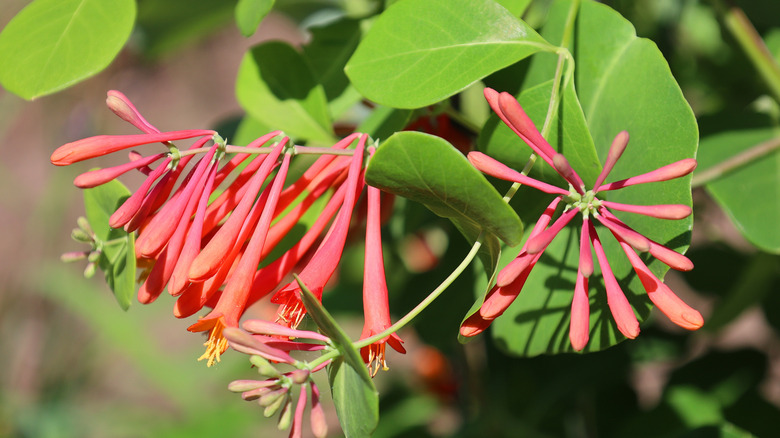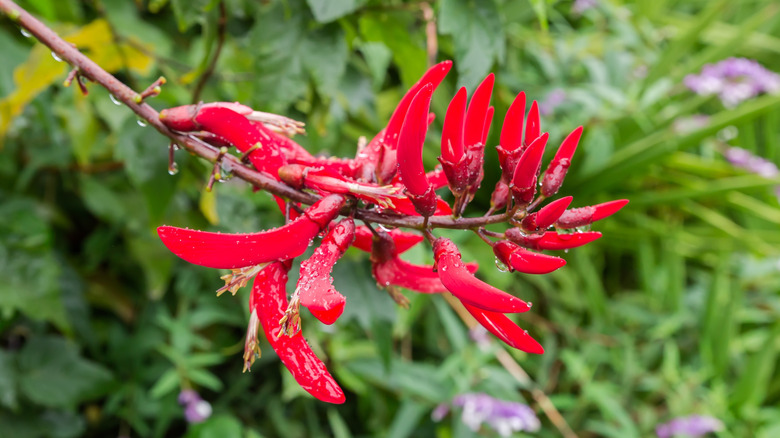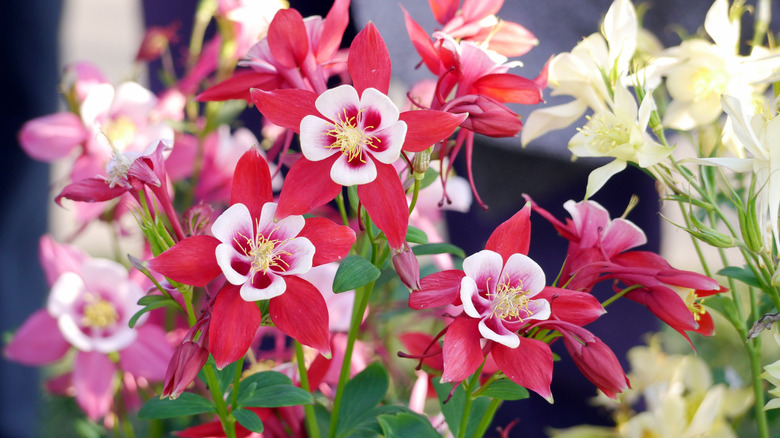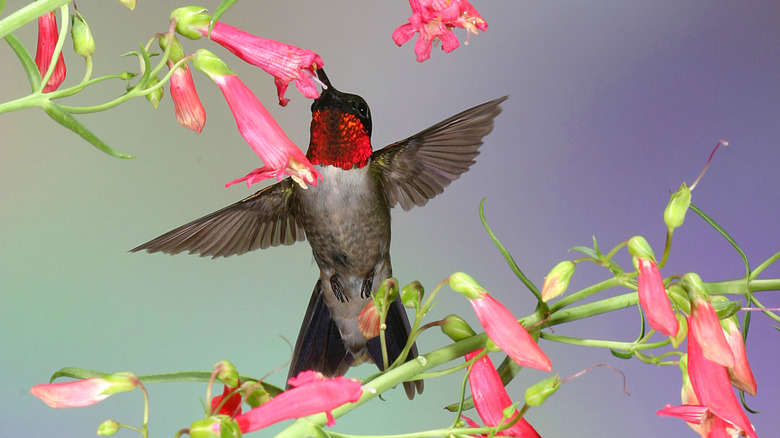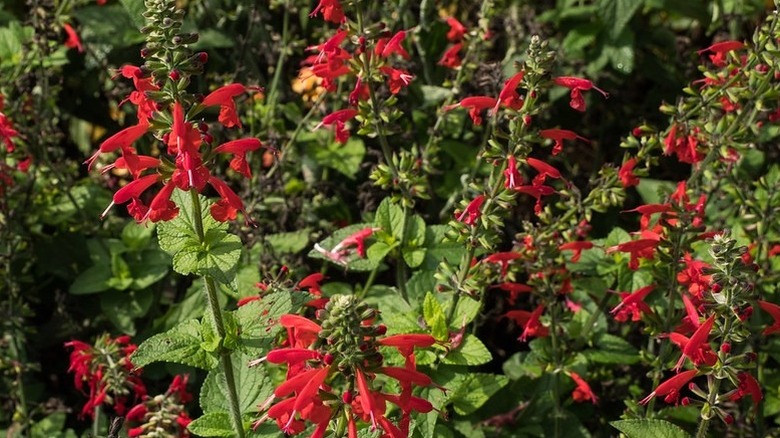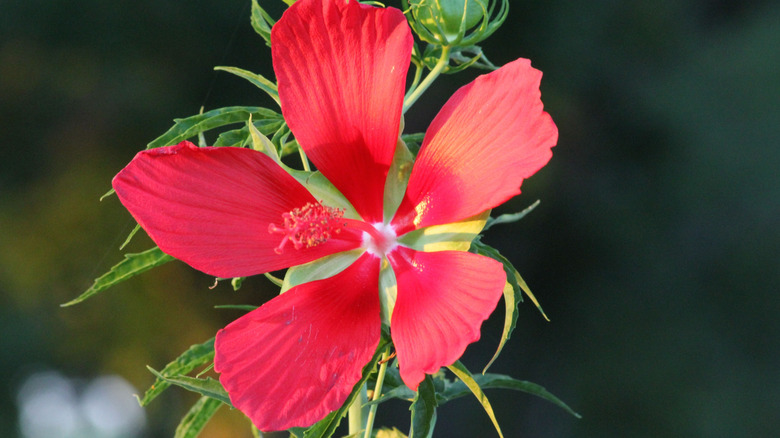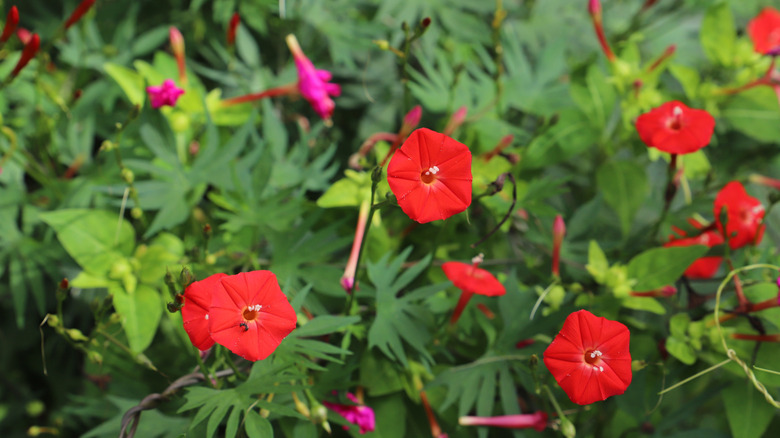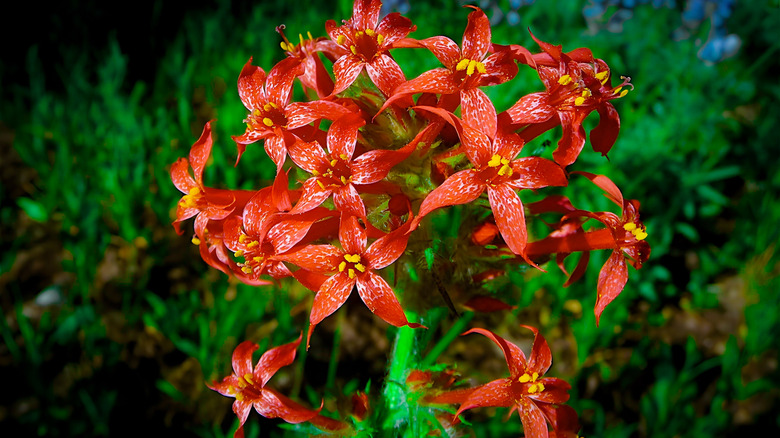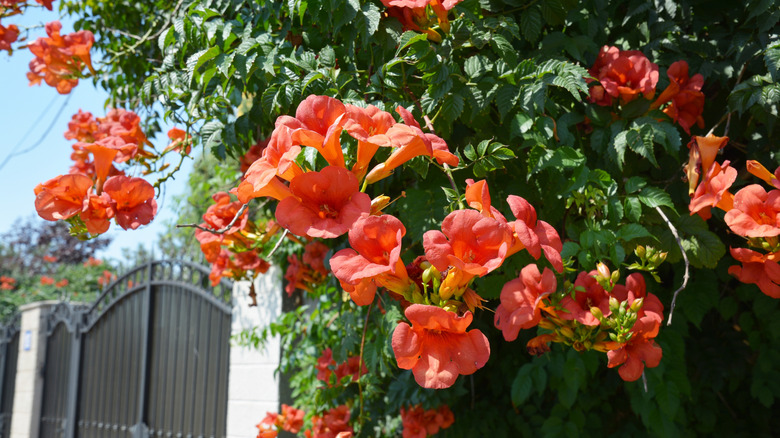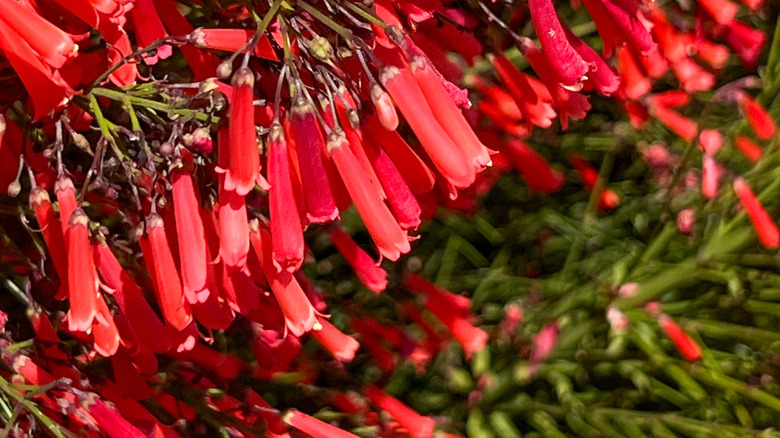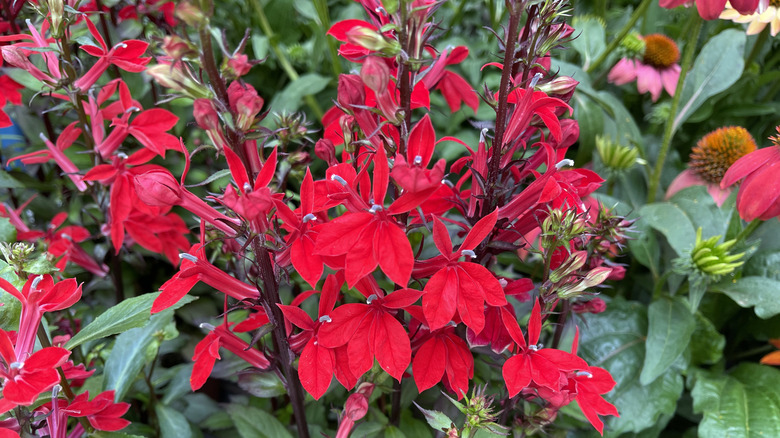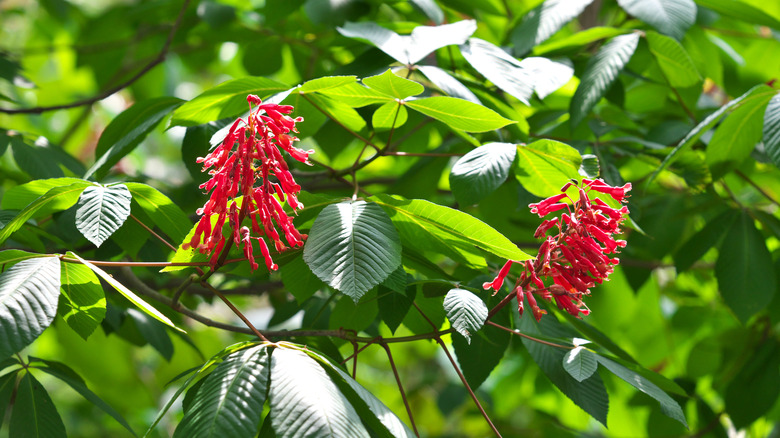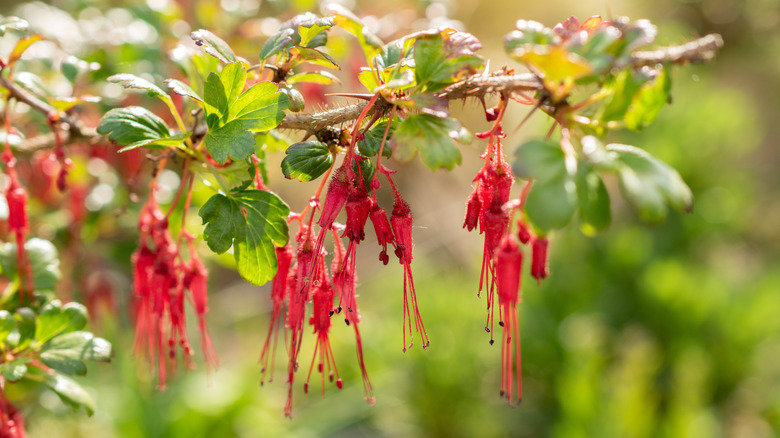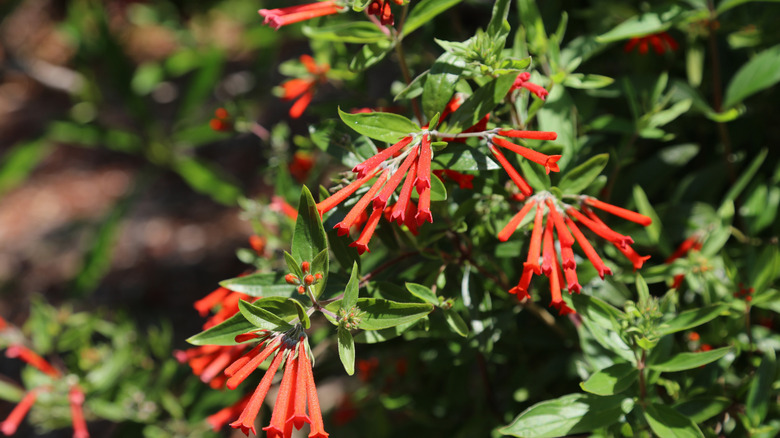16 Vibrant Red Flowers To Plant And Grow If You Want To Attract Hummingbirds
Red flowers instantly draw the eye with their bold colors, and inspire displays of stupefied awe with their beauty. Jewel-toned hummingbirds seem to share the same sentiment. Celebrated as a keystone species, hummers as a collective usually gravitate toward vibrantly-hued, tubular flowers teeming with nectar. So, it's no wonder that red has become the go-to color to instantly invite more hummingbirds to your garden (though orange and pink-colored blooms are also favored).
To make the red-flowering plants work as hummingbird magnets, plant them in clumps or groups, instead of opting for scattered plantings. Also, incorporate multiple species so your garden blooms year-round, fulfilling the food requirements of resident, as well as migrant, hummers. Better yet, include plants native to your area, as the local hummingbirds are already familiar with them and will fly in for their nectar. The red flowers discussed below are native to the U.S., but may not be to your specific area — use Audubon's Native Plant Database for zip-code-specific recommendations.
Use coral honeysuckle for attracting hummingbirds early in spring
Since not many plants actively bloom during early spring days, planting coral honeysuckle (Lonicera sempervirens) in your garden beds ensures your area's hummingbirds don't go hungry. From May onward, these climbing vines are covered in nectar-rich, bright red, tubular blooms that ruby-throated and broad-billed hummingbirds feed from. To ensure the vines continue flowering through early fall, you must prune them after the first blooming wave terminates. Alternatively, grow 'Major Wheeler,' a hybrid cultivar that prolifically blooms coral-red flowers from mid-May through frost.
Since coral honeysuckle can climb about 15 feet high, you can use this gorgeous flowering plant to add color and privacy to your space. Although hardy in Zones 4 through 10, it is evergreen only in warm climates and returns from roots elsewhere during spring. It is native to the southeastern U.S., adapts to most soils, barring dry, sandy soils, and tolerates drought. Give it at least six hours of direct sun exposure to maximize flowering and pollinator action — even songbirds, butterflies, and moths enjoy their fruits and foliage. As these vines can be highly flammable, plant them outside your home's defensible zone.
Ocotillo assists broad-tailed hummingbirds on their spring voyage
You can attract hummingbirds without a feeder by planting a nectar-rich flowering shrub: ocotillo (Fouquieria splendens). But keep in mind that it has a unique form. Also known as vine cactus, ocotillo appears as a bare mass of spiny, spindly sticks in its non-flowering form. However, once it's rained on or irrigated, it turns green. Waxy red flowers materialize like blazing hot torches during spring and summer, which carpenter bees and hummingbirds pollinate. Broad-tailed hummingbirds drink their nectar, along with spiders and bugs hiding in their foliage during their spring migration to the north. Costa's, broad-billed, black-chinned, and lucifer hummingbirds also frequent their flowers.
Ocotillo traces its origins to the southwest U.S, and is a rock garden standout. It has minimal water needs and can be homed in drought-tolerant gardens exposed to full sun. Even if you don't irrigate it, the plant will survive by shedding all leaves and re-greening when you do — a process it repeats multiple times throughout the year. Ocotillo can tolerate temperature dips to 20 degrees Fahrenheit, making it hardy up to Zone 8.
Coralbean's blooms flare out like crescent moons, attracting hummingbirds
While it's still bare in the spring, coralbean (Erythrina herbacea) produces sprays of red petals shaped like crescent moons that ruby-throated, broad-billed, buff-bellied, and violet-crowned hummingbirds find attractive. This spring show is soon followed by the display of black pods that break apart to reveal vivid, crimson-red seeds, offering visual appeal in the summer. In mild climates, coralbeans can rebloom in the fall.
In Zones 8 through 11, where it can overwinter dependably, coralbean can grow into a 12-foot-tall tree. However, since it takes well to pruning, you can maintain it at a more manageable height and mass it in borders and container gardens. If you choose to plant it around fences for flowering cover, complement it with evergreens that mask its dying foliage. Coralbean seeds are toxic to pets and children, so when you harvest the seeds for planting next year, ensure you limit access. Fertile, sandy soils exposed to full sun or moderate shade make optimal sites, even if watered less, since they tolerate drought.
Columbines are excellent specimens in shaded spots
Comprising over 65 species and hybrids, columbine (Aquilegia spp.) is available in a range of habits, forms, and colors, including red. And depending on your location, you're sure to find a variety native to your area. For instance, in the east, Canadian or wild columbine (A. canadensis) is popular with ruby-throated hummers, as they move north during spring. On the other end, western red columbine (A. formosa) holds the attention of rufous, Allen's, and broad-tailed hummingbirds (birds sparking conservation concern), apart from the resident populations of white-eared hummingbirds.
Regardless of the variety, columbines are hardy in Zones 3 through 9, and are united in their love for partially-shaded spots. While you can push them into sunnier beds, frequent irrigation is a must for more blooms. Although columbines don't live for long, you're unlikely to feel their absence since they self-sow their seeds. But if you're growing more than one variety, they may cross-fertilize, birthing plants dissimilar to their parents. The only drawback? You'll have to watch out for leafminers.
Bearded penstemon attracts a wide diversity of hummingbirds, and is drought-tolerant
As long as your area lies within their habitat or feeding range, you can expect bearded penstemon (Penstemon barbatus) to drive in massive hummingbird traffic. Costa's, rufous, Allen's, broad-tailed, broad-billed, calliope, white-eared, blue-throated, and Anna's hummingbirds are all attracted to their reddish-orange flowers that become available in late spring and summer (in rare cases, as late as October). To extend their lifespan and maximize flowers, plant in full sun and poor soils, and clip off faded blooms regularly.
Also known as scarlet bugler, bearded penstemon is indigenous to the arid areas of the southwest U.S. Considering its origins, this red-blooming perennial is ideal for rock gardens located in Zones 4 to 8, or xeriscapes, where its drought tolerance will be valuable. It can grow about 3 feet tall and half as wide, and may be used in dry beds and borders to deter deer. When the plants grow too big for the space, separate the clumps in spring to spread the love elsewhere.
Scarlet sage reliably blooms for hummingbirds during peak summer
Unlike most flowering plants that begin to look drab and sad in hot summers, scarlet sage (Salvia coccinea) comes into its own around this time. From early summer (or spring in hot climates), it blooms its head off, boasting whorls of red petals that last through the fall. Indeed, given their high nectar content, hummingbirds, including ruby-throated, rufous, and Allen's, often prefer it over other red-blooming flowers. However, to utilize this red flower to entice hummingbirds, make sure to plant it en masse. Since it's a fast grower and self-seeds readily, allow it to roam free and naturalize a bare patch that offers you a nice vantage point. You must also water it diligently through the summer, or the blooms won't be as nice.
Scarlet sage is indigenous to parts of Mexico and the southeastern U.S. and reliably overwinters in Zones 8 through 10. Beyond that range, you can grow it as an annual in sunny borders — deer-resistance and attraction to butterflies are bonuses. Or, pop it in colorful containers to dress your walkways and patios.
Scarlet beebalm attracts hummingbirds, but not deer
Scarlet beebalm (Monarda didyma) is one of the top flowers to plant for luring hummingbirds into your garden. The burgundy red flowers are available all summer long and are a favorite among ruby-throated hummers along with bumblebees. Gardeners also enjoy beebalms for the minty fragrance radiating from their leaves.
Native to the eastern U.S. states, scarlet beebalm is notorious for its spreading tendencies — Illinois labels it as a nuisance weed. It profusely produces seeds and rhizomes, which enable its spread in the garden. To avoid any unseemly takeover, remove the spent blooms and yank out volunteers. You must also divide the plants every three years for containment. Otherwise, such overcrowded beds may stifle air circulation, making them susceptible to powdery mildew, though under-watering can bring about a similar outcome. Hybrids like 'Jacob Cline' exhibit some resistance to mildew. In Zones 4 through 9, scarlet beebalms can be grown in slightly acidic, rich soils exposed to full sun. Thankfully, they're unpopular with deer and bunnies, and can be utilized in borders for deterrence.
Use scarlet hibiscus to lure in hummingbirds in marshy sites
For truly large flowers that scream hummingbird food, incorporate scarlet hibiscus (Hibiscus coccineus) in your boggy gardens. In mid-summer, it shoots out 6-inch-wide, deep red blooms, brimming with sweet nectar. Assuming the deer and squirrels in your area haven't chewed off the plant, expect to see many ruby-throated hummingbirds hovering around it until fall.
Scarlet hibiscus is native to the marshy lands of Florida and Georgia, earning it monikers like marsh hibiscus and swamp mallow. This also implies you can incorporate it in marshy areas, including ponds, in Zones 8 through 10, where it's a perennial. As the plant can sometimes grow nearly 8 feet tall, use it as a specimen if planting in small areas and mass it where the space allows. Although some shade is tolerated, full sun will bring out the best blooms. You'll have to monitor the foliage for grasshoppers and borers. Retain the dead foliage through spring, as native bees overwinter in their hollow stems.
Cardinal climber is a low-maintenance vine that hummingbirds find irresistible
An heirloom vine, cardinal climber (Ipomoea x multifida, syn Ipomea sloteri), unfurls its vividly red blooms mid-summer, with the display lasting well into fall. The white or yellow lines running down the throat lead butterflies and hummingbirds, including ruby-throated and broad-billed, to delicious nectar.
With the exception of Zones 10, 11, and 12, cardinal climber is an annual elsewhere in the country and low maintenance, as any vine can be. You don't ever have to worry about pruning these beautiful plants, unless you wish to control their height. Nor do you need to fertilize them in average garden soils. Simply prop up a tall trellis or arbor in a sunny or lightly-shaded area and sow the seeds for gorgeous blooms. Alternatively, allow it to form a dense ground cover or use it in hanging baskets. In mild climates, it'll self-seed judiciously, requiring no additional work from the gardener, save for removing any excessive, volunteer seedlings. In colder regions, however, you'll have to save the seeds from the green pods for next year's planting. Remember to don gloves and keep pets away while you undertake this activity, as the seeds are very toxic.
Scarlet gilia weaves a rare focal point with a mix of red and white flowers, but doesn't smell great
Scarlet gilia (Ipomopsis aggregata) is another unique flower that attracts hummingbirds with its color-changing blooms. During early summer, its 3-foot-high clump is clothed in yellow-splashed, red flowers that easily garner the attention of broad-tailed and rufous hummingbirds. Yet, greedy for more attention, scarlet gilia can switch to white-colored blooms in late summer months to attract pollinating moths. However, this phenomenon is more frequent in areas where hummingbirds are migratory and not resident. Suffice to say, by the end of the growing season, you'll have a distinctive plant with a mix of red and white flowers until it's frost-killed.
Although scarlet gilia looks quite ornate, don't plant it near walkways to avoid breathing in the unpleasant smell emanating from its foliage (it's often called "skunk flower"). It is native to the western U.S. region and can be successfully grown in dry, partially-shaded, sandy soils in Zones 6 to 9. It also thrives at elevated heights of 10,000 feet. While it's short-lived, scarlet gilia often returns by self-seeding.
Trumpet creeper brings in hummingbirds all summer long, but can be invasive
Trumpet creeper (Campsis radicans) is a beautiful flowering vine that will keep hummingbirds coming back to your yard every summer with its nectar-laden, orangish-red blooms. These southeast U.S. natives coincide with the range of ruby-throated hummingbirds, though they also draw the attention of nesting Rivoli's and migrating buff-bellied and blue-throated hummingbirds. Per usual, grow in full sun to maximize flowering. Pruning hard in late winter may spur new flowering shoots.
Hardy in Zones 4 through 10, trumpet creeper is not the easiest plant to maintain. While you'd appreciate its chokehold on hummingbirds and the ability to mask ugly features like stumps or rock piles with its dense growth, it's an aggressive invader. Through its runners and self-seeding, trumpet creeper takes over garden beds and smothers surrounding vegetation. It has also become invasive in the southeast U.S., earning itself unsavory names like devil's shoestring. To manage its growth, continuously deadhead the faded blooms, pull out or mow the seedlings, or plant near the hardscape. If not, consider planting its well-behaved cultivar 'Indian Summer,' which produces orange-red blooms in late spring. Sensitive individuals may face skin irritation from its milky sap.
Use California fuchsia to fuel hummingbirds migrating south
Toward summer's end, California fuchsia (Epilobium canum, formerly Zauschneria californica) is laden with scarlet red flowers that hummingbirds feed on while migrating to the south. Additionally, Anna's hummingbirds, which are resident in the Pacific Coast, seek these blooms for nectar until they terminate in the autumn. No wonder California fuchsia has earned itself the epithets of hummingbird trumpet and hummingbird flower.
When planted in coastal gardens, California fuchsia is easy to maintain. That's because it can do without any irrigation, even during hot summers, after it has established. However, if you're aiming to put in dry, inland beds, you must water it monthly to ensure the flowering display continues unabated. Cutting back the foliage to the ground after flowering should ensure healthy growth in spring. Since it's fire-resistant, you can place it in foundation beds to enjoy a better view of hummingbirds. However, you may have to remove volunteer seedlings to keep them contained. California fuchsia is native to the western U.S. region and cold-hardy in Zones 8 through 11.
Utilize red cardinal flowers to draw in hummingbirds to wet sites
Most pollinating insects find it challenging to navigate the tubular blooms of red cardinal flowers (Lobelia cardinalis). But hummingbirds find their gorgeous, bright flowers just perfect, and have established a symbiotic, pollinator relationship with these plants. Matching the shade of the Catholic robes, these vermilion red flowers are available during the summer-fall transition, hosting ruby-throated hummingbirds whose range overlaps with them in the eastern U.S. region.
Red cardinal flowers are ideal in moist-to-wet sites, as they can tolerate short flooding. So, if you're looking to populate the area around ponds or cultivate a rain garden, give these herbaceous perennials a chance as a focal point for pollinators. They can also handle partial and dappled shade, and are appropriate for woodland lots in Zones 3 through 9, often adding vertical interest with their 5-foot-high stems. If consumed, their toxic alkaloids can prove dangerous, so choose their site where pets and children won't have access. Their self-seeding ensures the plants will return reliably year after year. However, to establish them for the first time, use transplants, because seeds and seedlings aren't as successful.
Red buckeye pulls in spring-migrating hummingbirds
If you're seeking the best flowers for attracting ruby-throated hummingbirds during spring migration, red buckeye (Aesculus pavia) is a strong contender. The maroonish-red flowers burst out in late winter, serving as an early nectar source for journeying hummers and butterflies, until other plants flower in the spring.
Red buckeye is native to the U.S. and grows reliably in Zones 4 to 8. It can grow quite tall, reaching heights and breaths of 20 feet or more, relegating its use as a specimen. If space is limited, pair red buckeye with other hummingbird-friendly, red flowers, such as coralbean, trumpet creeper, and firebush — they'll also help cover up buckeye's dispirited foliage toward the end of the growing season. In woodland settings, develop it into a flowering hedge or combine it with tulip trees that also host spring-migrating hummingbirds. Red buckeye enjoys partial shade and moist, fertile soils. Keep furry friends and curious children away from it, as consumption in tiny amounts can be fatal, too.
Fuchsia-flowered gooseberry offers nectar to migrating hummingbirds during winter
Breezing in the wind, the fuchsia-red flowers on the fuchsia-flowered gooseberry (Ribes speciosum) appear as if someone let the ballerinas free. And hummingbirds, particularly Allen's, read it as an invitation to feast on nectar. As these fast-growing shrubs bloom in peak winter months of January through spring, they're also valuable to spring-migrating hummers.
Fuchsia-flowered gooseberry is native to California and cold hardy to mercurial dips of 20 degrees Fahrenheit. It thrives in partially or heavily-shaded sites with minimal irrigation (and not at all if planted in clay). In drought-hit areas, it survives by shedding leaves. But when it manages to retain its foliage, you're in for gorgeous fall colors. Unfortunately, it's a lair of thorns and you must account for it while choosing its planting location to minimize any direct contact.
Firecracker bush puts out red blooms from spring through fall
Also known as scarlet bouvardia, firecracker bush (Bouvardia ternifolia) presents a spectacular sight for months on end. Its tubular, red blooms literally smother the dark green foliage, starting from spring until the hard frost puts them out of business, to the utter delight of broad-tailed hummingbirds.
Evergreen perennials in Zones 7 to 10, firecracker bushes may be grown in containers elsewhere and overwintered inside. They're indigenously found in the rocky areas of Texas, Arizona, and New Mexico. Snip off the dead blooms regularly to encourage reblooming and tidy their appearance. Give them a home in dry, partially-shaded sites that drain well. They're drought-tolerant and can grow over 2 feet tall and wide.

